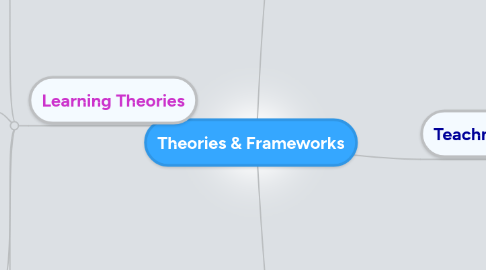
1. Learning Theories
1.1. Behaviourism
1.1.1. Theorists: Pavlov, Watson, Thorndike, Skinner
1.1.2. Key Ideas: practice makes perfect, punishment / consequences, operate conditioning modelling, shaping, cuing
1.1.3. Instruction: teacher directed, learning objectives,
1.1.4. Technologies: CAI, CAA, YouTube, IClickers, math blaster (reward games) etc
1.1.5. Criticisms: oversimplifies learning, extrinsic motivation, mind is not a blank slate, learning is not always tied to behaviours
1.2. Cognitivism
1.2.1. Theorists: Piaget, Gagne, Vygotsky, Bruner
1.2.2. Key Ideas: schema, scaffolding, memory (sensory, STM, LTM), motivation, organization, mental maps
1.2.3. Technologies: digital concept mapping, electronic note taking,
1.2.4. Criticisms: ignored affective and psychomotor, difficult to measure understanding
1.2.5. Cognitive Load Theory
1.2.5.1. chunking, learning structures, instructional design, fundamental attribution error, processing information can over or under load working memory
1.3. Constructivism
1.3.1. Key Ideas: learning is built on connections, teacher is facilitator, problem-based tasks, real world connections
1.3.2. Technologies: google sites, wiki sites, blogger
1.3.3. Criticisms: time consuming, difficult assessment, mature students required, COMPLEX
1.4. Connectivism
1.4.1. Theorists: Siemens, Downes
1.4.2. Key Ideas: developing connections, and creating a network, current, diversity of options
1.4.3. Technologies: Twitter, Facebook, MySpace, google (search engines)
2. Technology Theories
2.1. Media Ecology: technology influences society (Postman, McLuhan), digital era, medium is the message, hot / cold (involvement) media
2.2. SCOT: Social Construction of Technology, society and human action influence technology (Bljker, Pinch), symmetry, closure
3. TPACK
3.1. Technology Knowledge - teaching the content around computers and regarding HOW to use computers, takes into account content and pedagogy of technology
3.2. Pedagogy Knowledge - the ideas around how to teach specific content, based on Gardners Multiple Intellegence theory
3.3. Content Knowledge- based on the content of the curriculum, the content of the Alberta Program of Studies (recently technology has become an aspect of content in the Program of Studies at the elementary level)
3.4. TPACK - a mixture of all three, most benefitial to the students learning
4. Teachnology
4.1. Awareness, comfort level, based on interest not age, 21st century learning, communication, collaboration, integration within all subject areas, critical thinking skills
4.2. Giving students the most tools to become successful (career and life skills)
4.3. It is important to teach technology safety (cyber bullying) and how to use the internet / technology properly
4.4. Best Practices
4.4.1. Alignment: incorporation of technology must have a purpose
4.4.2. Accessible: issue of funding? Become familiar with what is available.
4.4.3. Assessment: goes in accordance with alignment, must be specific to outcomes, can use as a way to assess
4.4.4. Reinforcement: Supplement teaching
